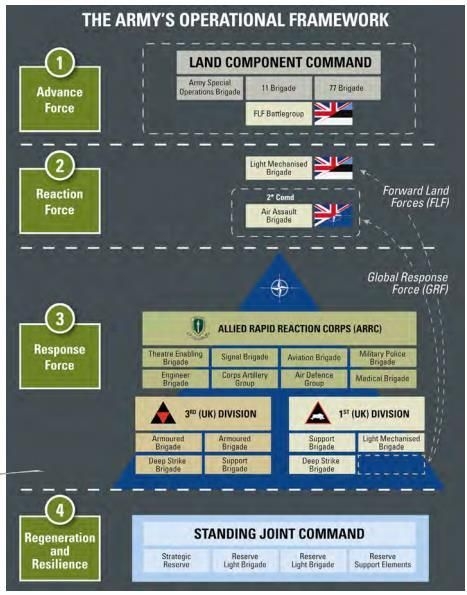
The British Army, in its new main role of providing a Strategic Reserve Corps to SACEUR, will field two small Divisions each with two manoeuvre brigades and a “Deep Recce Strike” brigade combining cavalry and long-range Fires. This largely confirms what we reported earlier about the future of the British Army on FW MAG 4/2025 while admitting that resources are simply not in place to expand the Divisions to make them closer to NATO indications (which indicate an ideal composition of 4 manoeuvre brigades per Division).
3rd Division will be a Heavy formation, with CHALLENGER 3 and ARES vehicles (AJAX-family) for the infantry within its manoeuvre brigades, 12 and 20. It is expected that 3 regular tank regiments will remain in the force, with the individual regiments adopting a Type 44 structure in terms of MBTs, but with the addition of a ‘Strike Squadron’ equipped with AJAX and dismount capabilities including snipers, ATGWs and mortars.
101 Logistic Support Brigade will sustain the Division. The British Army will again diverge from NATO indications in that it appears to plan on the consolidation of Combat Support and Combat Service Supports in supporting brigades, rather than outfit each brigade with fully organic resources. The Deep Recce Strike brigade will remain centred on the M270s GMLRS of 26 Royal Artillery regiment.
The majority of BOXER vehicles will eventually move into 7 Brigade, within 1st Division, while 4 Brigade will be a lighter mechanized brigade using FOXHOUND and probably new vehicles acquired under the Land Mobility Programme – Medium segment. 102 Logistic Support Brigade will sustain 1st Div and a Deep Recce Strike brigade will be formed, presumably centred on the GMRLS (M270s) of 3 Royal Horse Artillery.
The volunteer Reserve will be concentrated into 2 Light Brigades which will be “structured to train as they will fight”, suggesting some radical restructuring is coming since at present only 1 reserve brigade is in place (19 Bde) and it is an administrative “bag” for infantry battalions more than a fighting formation.
11 Brigade will be retained as a “forward defence” formation which will eventually play a key role in the British Army’s contribution to NATO’s Forward Land Force in Estonia. The Army Special Ops Brigade with its RANGERs and 77 Bde with its Information Warfare capabilities will also be constantly active in defence of the Alliance.
The mechanized brigades of 1st Division, along with 16 Air Assault Brigade (and 1st Aviation Brigade elements, which together with 16 form the ‘Global Response Force’), will be the “first responders” formations in times of crisis.
Both Divisions will be under the direct control of the Allied Rapid Reaction Corps, which will also assume control of 7 Air Defence Group, 8th Engineer Brigade, 104 Theatre Enabling brigade and other supporting elements (medical, MP etc). The ARRC has formed the core cell of a Multinational Artillery Brigade / Corps Artillery Group.
Some clarity has been added on the drone plans in the immediate, as well: 3,000 First Person View strike drones are being delivered as of this month. By the end of 2025, the battlegroup in Estonia (Operation CABRIT) will have 400 Modini DART 250 one-way strike drones at its disposal, with an attack range of 250 km.
1,100 additional small UAS for infantry ISR are due for delivery by December, while an additional 500 unspecified “attritable and consumable” larger drones for ISR are also being procured, to add to 90 PUMA AE and LE already in service and 99 STALKER being delivered under project TIQUILA.
Project CORVUS in the coming months will be selecting a new large drone as replacement for WATCHKEEPER, with an initial fleet of 24 planned to constitute a first two 24/7 Task Lines. WATCHKEEPER will remain in use at least out to April 2026 in the meanwhile.
Under Project NYX, an Autonomous Collaborative Platform is being sought to assist the AH-64E APACHE gunships. The ACP drone is expected to lift at least 200 kg in weaponry.
Project ATTILA, building on the earlier WEEVIL demonstrator, has been launched to convert a first 6 WARRIOR into autonomous breaching vehicles fitted with full width mine ploughs. It is also intended that this work will enable development of plans for Heavy UGV use for other missions and applications.
Follow us on Telegram, Facebook and X








.png)
